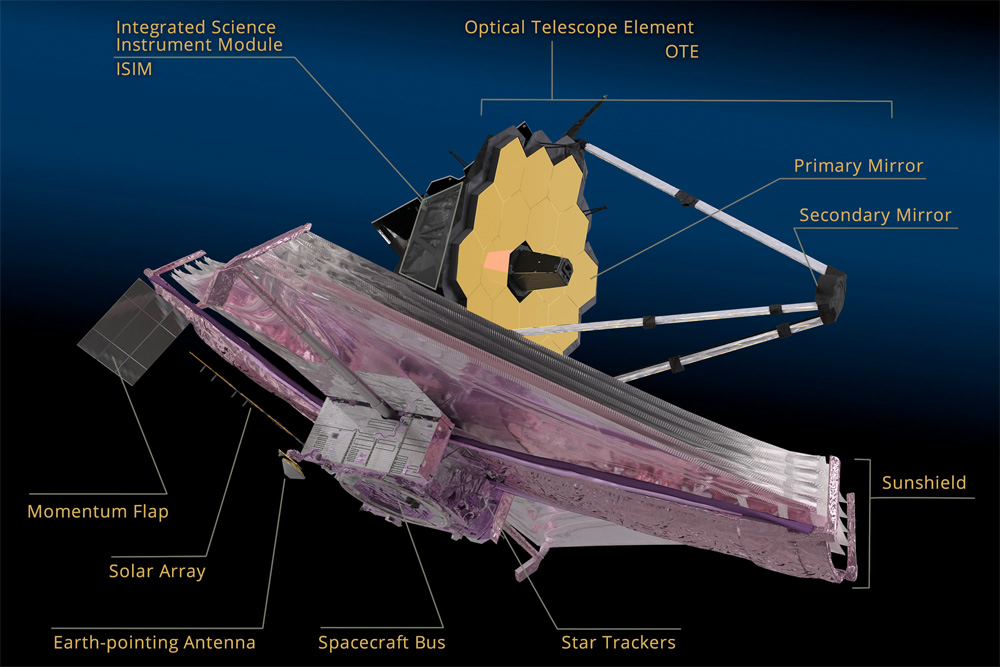EDITOR’S NOTE: President Joe Biden will hold participate in a White House event at 5 p.m. EDT (2100 GMT) Monday to reveal the first science image from the James Webb Space Telescope. Additional images will be released Tuesday. Our colleagues at Astronomy Now will host a live webcast of the image unveiling beginning at 4:45 p.m. EDT (2045 GMT). NASA TV coverage will begin at 5 p.m. EDT (2100 GMT).
Astronomy Now Webcast
NASA TV
In a White House event planned for 5 p.m. EDT (2100 GMT) Monday, President Joe Biden will give astronomers, space enthusiasts, and the general public a look at the first science image from the James Webb Space Telescope.
The early unveiling, announced late Sunday, will come one day before the long-planned release date for the first Webb science images Tuesday, when officials from NASA, the European Space Agency, the Canadian Space Agency, and other research institutions will reveal the observatory’s first glimpse of a range of cosmic wonders.
Webb launched on Christmas Day on top of a European Ariane 5 rocket, and arrived at its operating orbit nearly a million miles (1.5 million kilometers) from Earth in January. Since launch, the $10 billion observatory opened its mirror and sunshield, allowing its instrument detectors to cool down to cryogenic temperatures, not far above absolute zero.
Over last few months, ground teams have calibrated Webb’s instruments and aligned the telescope’s mirror segments. The telescope’s performance exceeds design specifications, officials saiid.
Webb’s segmented primary mirror — with a diameter of 21.3 feet (6.5 meters) — is the largest ever put into space. The mirror’s light collecting power, coupled with its sensitive, super-cold detectors, allow Webb to peer deeper into the universe — and farther back in time — than humans have ever seen before.
Before Webb, the Hubble Space Telescope was the benchmark for space-based astronomical observatories. Launched in 1990 with a mirror a third the size of Webb’s, Hubble’s suite of instruments observing in ultraviolet, visible, and near-infrared light wooed astronomers with views of distant galaxies, colorful clouds of gas in star-forming nebulas, and provided measurements of the expansion rate of the universe.
Astronomers have used Hubble to stare deep in cosmic history with a series of “deep field” images, each showing thousands of previously-unseen distant galaxies in a tiny postage stamp section of the sky. One of the images, called the Hubble Extreme Deep Field, was released by NASA in 2012, revealing some 5,500 galaxies of all shapes and sizes by combining observations with two of Hubble’s instruments with a total exposure time of 23 days.
The oldest galaxies in the Hubble Extreme Deep Field were seen as they were 13.2 billion years ago, some 500 million years after the Big Bang birthed the universe. Webb’s first deep field, which could be released Monday by President Biden, will look even farther into the past.

Scientists have said Webb, with its improved light collecting power and infrared instruments better tuned to the red-shifted light from the ancient universe, could see the first generation of stars and galaxies that shined just 100 million to 200 million years after the Big Bang. Elements fused in those objects helped seed the universe of today.
But that’s not all Webb will do.
“This telescope is so powerful that if you were a bumble bee 240,000 miles away, which is the distance between the Earth and the moon, we will be able to see you,” said John Mather, the mission’s senior project scientist at NASA’s Goddard Space Flight Center in Maryland.
“So what are we going to do with this great telescope? We’re going to look at everything there is in the universe that we can see.”
That runs the gamut from the most distant galaxies in the cosmos, to planets, moons, asteroids, and comets in our own solar system. Webb will be able to observe everything from Mars out, seeing details undetected by every other space observatory since Galileo revolutionized astronomy with his first telescope in 1609.
Webb will see through clouds of dust to study star-forming regions opaque to telescopes like Hubble. The light collecting power of Webb will also allow scientists to measure the chemical make-up of atmospheres on planets around other stars, revealing for the first time which alien worlds might be habitable for life.
Here’s a list from NASA of the science imagery and data scheduled for release Tuesday:
- Carina Nebula: The Carina Nebula is one of the largest and brightest nebulae in the sky, located approximately 7,600 light-years away in the southern constellation Carina. Nebulae are stellar nurseries where stars form. The Carina Nebula is home to many massive stars several times larger than the Sun.
- WASP-96b (spectrum): WASP-96b is a giant planet outside our solar system, composed mainly of gas. The planet, located nearly 1,150 light-years from Earth, orbits its star every 3.4 days. It has about half the mass of Jupiter, and its discovery was announced in 2014.
- Southern Ring Nebula: The Southern Ring, or “Eight-Burst” nebula, is a planetary nebula – an expanding cloud of gas surrounding a dying star. It is nearly half a light-year in diameter and is located approximately 2,000 light-years away from Earth.
- Stephan’s Quintet: About 290 million light-years away, Stephan’s Quintet is located in the constellation Pegasus. It is notable for being the first compact galaxy group ever discovered in 1787. Four of the five galaxies within the quintet are locked in a cosmic dance of repeated close encounters.
- SMACS 0723: Massive foreground galaxy clusters magnify and distort the light of objects behind them, permitting a deep field view into both the extremely distant and intrinsically faint galaxy populations.
Email the author.
Follow Stephen Clark on Twitter: @StephenClark1.
from Spaceflight Now https://ift.tt/QBpYRC5
via World Space Info







0 comments:
Post a Comment